A Look Back: 2018 in Review for UPS & FedEx
Last year was busy for the national parcel carriers, not only in terms of packages delivered, but in terms of changes to pricing and their respective service guides as well.
After warning shippers with the announcement of their 2018 General Rate Increase (GRI), UPS instituted mid-year increases to select surcharges related to size and weight. However, if shippers expected the annual announcement to cover the scope of the carrier’s pricing plans for the year, they’d have been surprised by the multiple, additional rate changes throughout the year, outside of the GRI:
- In April, UPS changed their fuel surcharge tables, separating the international export table from the domestic air table and effectively raising the fuel surcharge for export.
- In June, UPS introduced a Shipping Charge Correction Audit fee and increased the Over Max Limits charge by $150.
- In July, UPS implemented the Additional Handling fee and the Large Package Surcharge increases they had forewarned shippers about in their GRI announcement.
Of course, with the national carriers often moving in lockstep, it wasn’t long before FedEx joined UPS in changing rates midyear. In September, FedEx increased their Additional Handling fee for heavy packages, increased the Unauthorized Charge and, like UPS, changed the construct of their fuel tables by separating the import and export tables from the domestic express table and updating both the domestic ground and express tables.
As in 2017, when the busy-season pricing was first introduced to customers, both carriers instituted “peak” surcharges related to size, additional handling requirements, and other incremental increases during the peak shipping season between Thanksgiving and Christmas. Also mirroring 2017, UPS instituted a peak surcharge for residential shipping while FedEx did not. However, shippers can expect this disparity come to an end in 2019 and for FedEx to follow suit and implement the peak residential surcharge.
Both national carriers continued to place a premium on efficiency in 2018, in terms of space utilization and network efficiency, a that trend will continue going forward. While neither made changes to their dimensional weight pricing criteria, UPS did institute a shipping charge correction audit fee which penalizes shippers for incurring what UPS believes is an unacceptable number of shipping charge corrections in a given week, most of which are triggered by dimensional weight. In fact, UPS doubled down on the fee late in the year, making it easier for much shippers to incur the penalty. The audit fee is now assessed when the average shipping correction during an invoice week is more than $2.00. When they first introduced the fee, the trigger amount was $5.00.
Regarding the sheer number of total packages delivered, 2018 was a huge year for the national carriers. There’s little doubt that volumes were at a record high. Heading into Q4 2018, UPS indicated their expectation to deliver more than 800 million packages during the peak holiday season compared to roughly 762 million in 2017. Likewise, FedEx expected their peak volume to surpass their previous record number of packages, 400 million, also set in 2017. Not to be outdone, USPS predicted delivery of 900 million packages during 2018’s peak season.
season, internal Shipware data indicates that both carriers, as they have in past years, experienced delays during the critical peak holiday shipping weeks. A more thorough evaluation will be necessary once all of the data is in.
The 2019 FedEx & UPS General Rate Increases:
An exercise in elevating complexity to drive revenue
The close of each year is marked by both national carriers announcing their general rate increases for the new year. In November, FedEx Express and FedEx Ground announced a 4.9% average general rate increase while FedEx Freight announced a 5.9% average increase, both of which went into effect January 7, 2019. UPS’s announcement came almost a month later, on December 5th. Not only was the announcement atypically late in the year, but with a declared effective date of December 26, 2018, UPS gave shippers only three weeks’ notice of their average4.9% increase to UPS Ground, Air, International services, and Air Freight rates.
Outside of the actual percentage increases, the most important takeaway from each carriers’ announcement might be use of the word, “average.” Historically, there has been very little correlation between the carriers’ announced average increase and the actual increases by service level, zone, and weight. This year’s announcements are no different.The impact to each shipper’s parcel budget will deviate significantly from the announced average increase depending on their shipper profile. The majority of small shippers are taking the full increase, while large shippers typically negotiate terms that mitigate the general rate increase year over year.
Consistent with more recent rate increases, the days of FedEx and UPS mirroring each other are fading. Reviewing the increase by service and weight shows that the biggest impact to FedEx customers will be the 6% to 8% increases to 31+ pound Express services. Similarly, UPS customers are facing increases between 7.5% and 8% to 31+ pound 2-day rates. However, the largest impact, and disparity from the 4.9% average, is seen in SurePost, with rate increases of 5% to 9.3%.
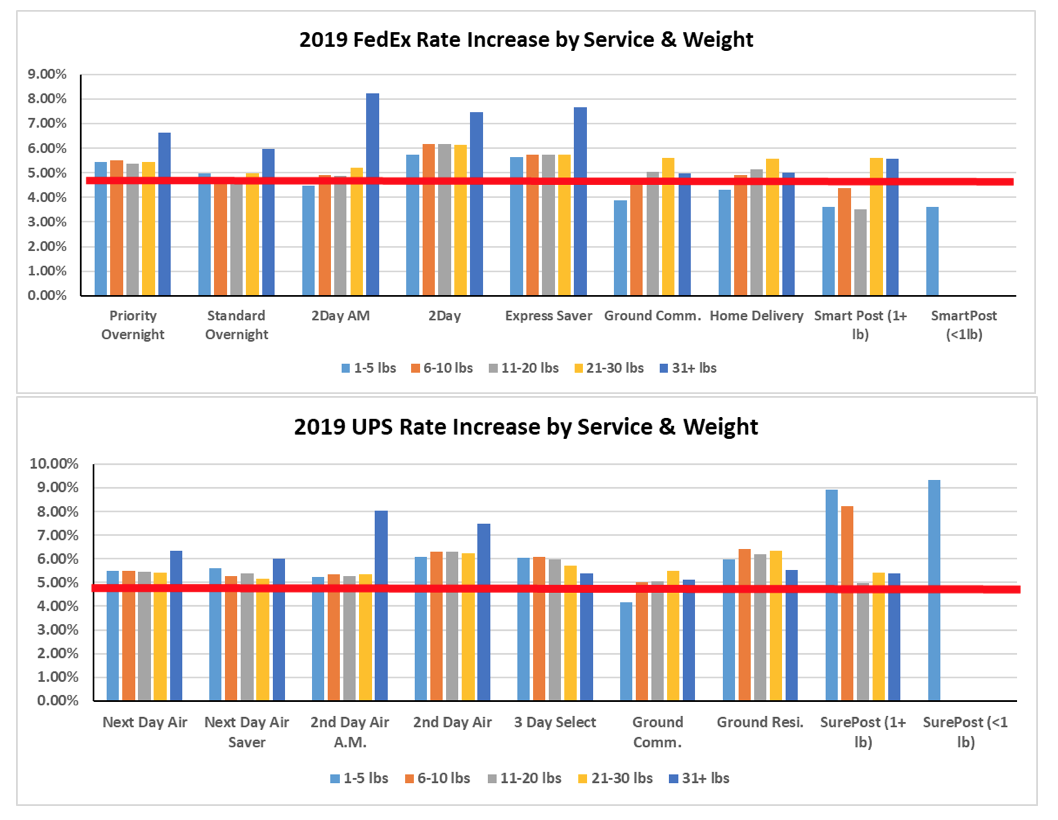
Dissecting the data reveals that the announced increases are indeed an average and will vary, along with their impact on shippers, by service and zone. With FedEx, we are seeing hikes across the board, above the average 4.9%, for all Express services while Ground Commercial, Home Delivery, and SmartPost hover between 4.7 and 5.2%. Conversely, UPS is mainly increasing its SurePost <1 lb. service by 8.9% to 9.8% while keeping SurePost 1+ lb., Ground Commercial, Residential, and 3-day shipments closer to the 4.9% marker. Like FedEx, 2-day and 3-day shipment increases vary by zone, from 5.4% to 8.1%.
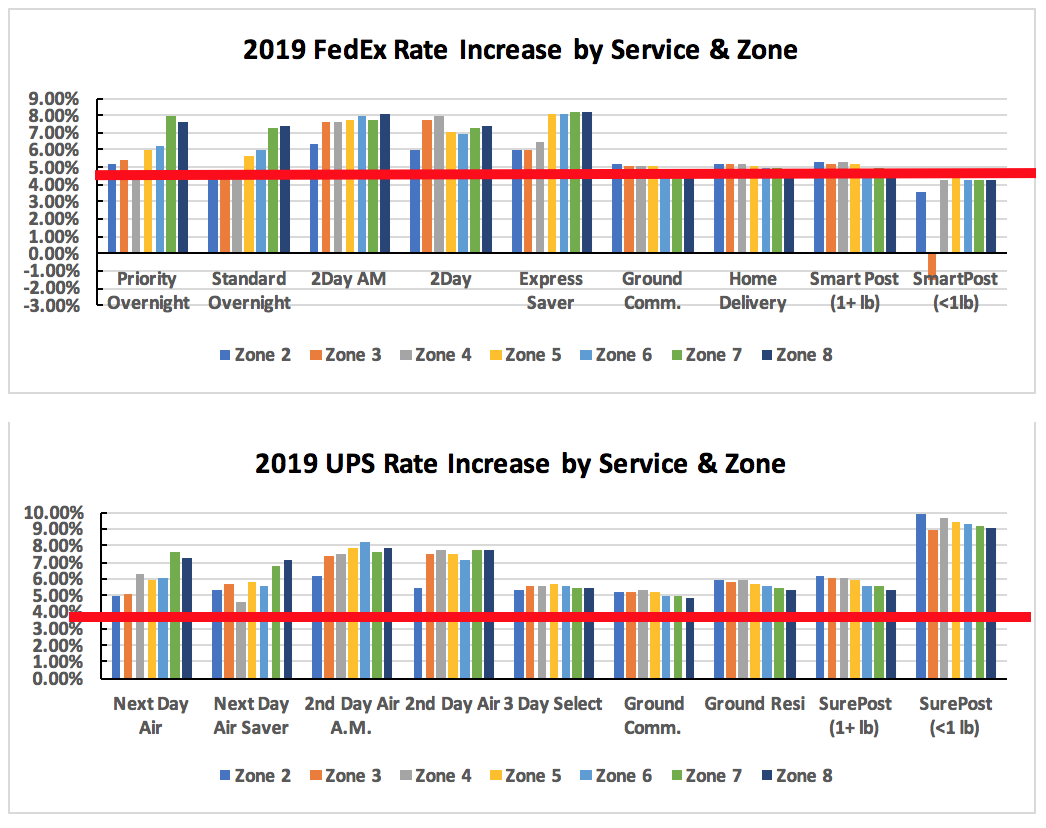
In addition to transportation rate increases, FedEx will increase surcharges and minimums in 2019. Notable changes are seen in the following two tables which show the zone 2, 1 lb. rate for each service:
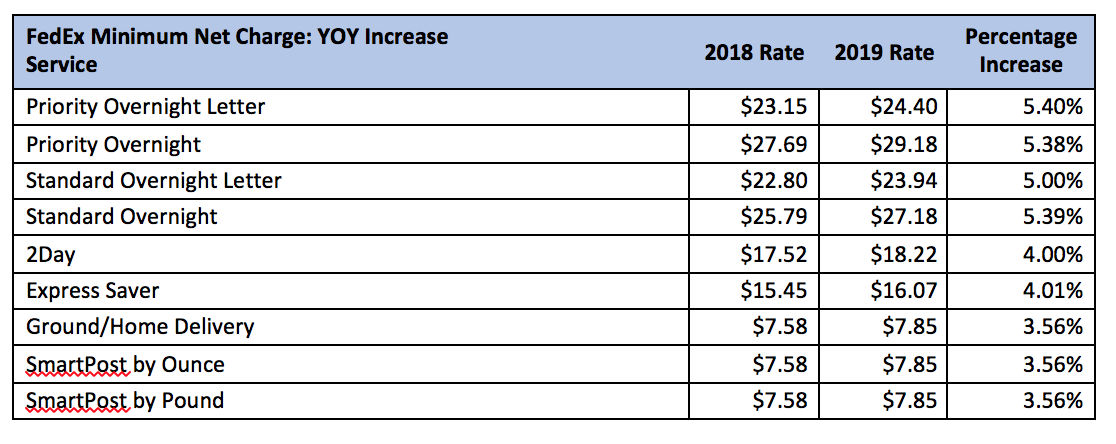
This list rate is reduced by a specified dollar amount predetermined by the carrier to arrive at the minimum net charge. FedEx minimums increases range from 3.56% on Ground/Home Delivery and SmartPost to 5.4% on Priority Overnight Letters while UPS increases move anywhere between the 3.7% on Ground to the 10.08% on SurePost greater than 1lb.
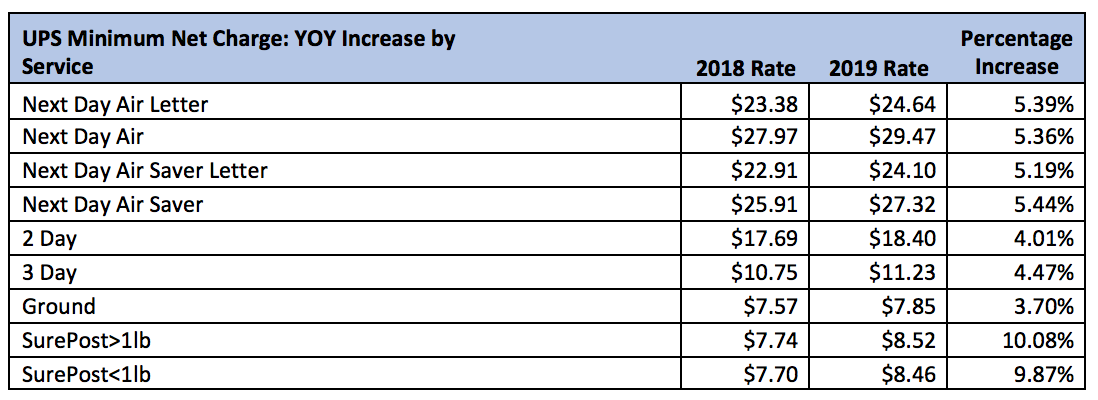
The table below highlights dollar and percentage increases to some of the more common surcharges. Note the outright number of surcharge increases, the variance in their amounts and, as noted before, the continuing trends of UPS and FedEx pricing moving farther apart, year after year, and the largest increases being reserved for those surcharges related to package size and dimensions.
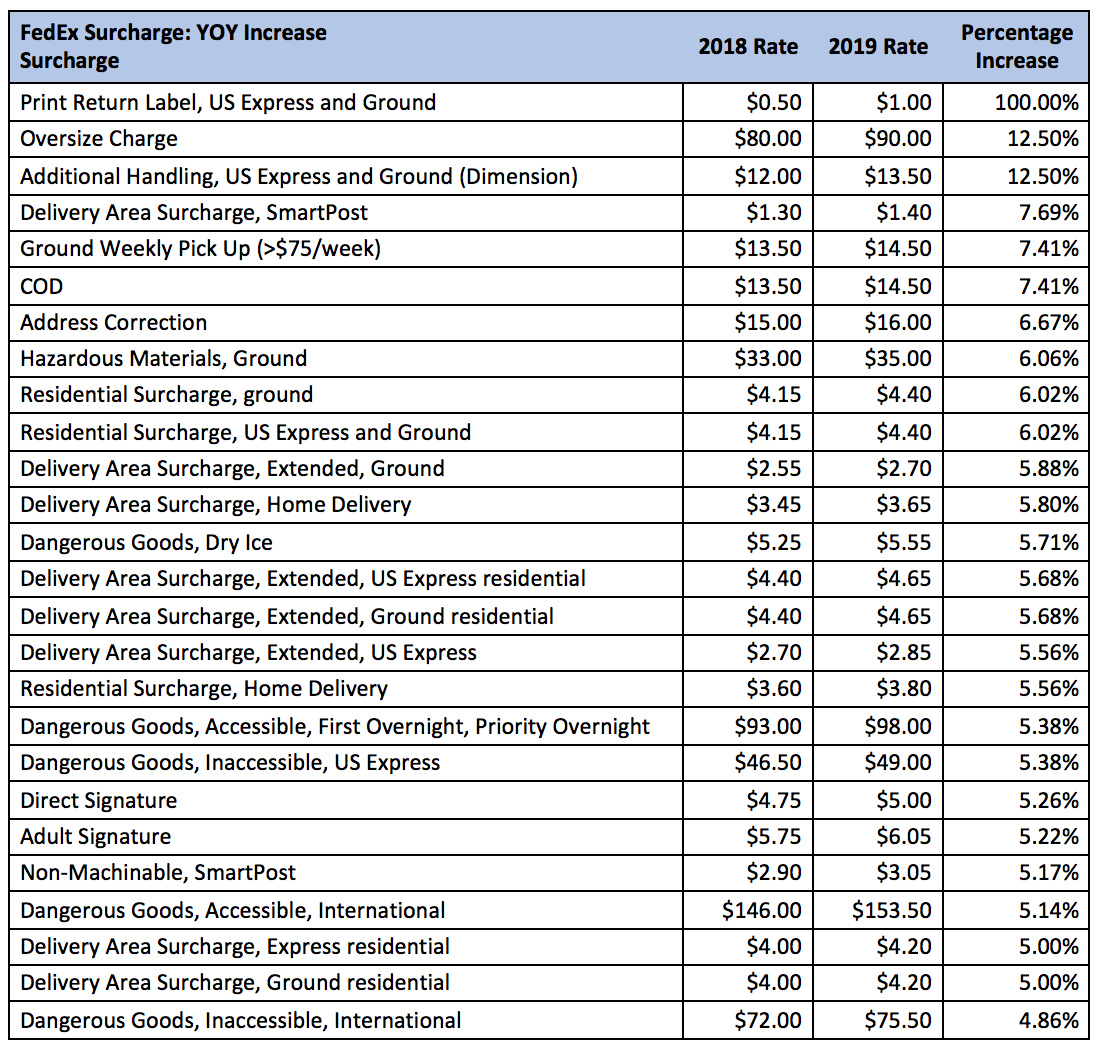
If you examined last year’s GRIs, you’ll recognize that many of the same surcharges increased last year are once again being increased in 2019, such as FedEx’s Print Return Label Fee which has doubled, and UPS’s Third-Party Billing Fee, up 80% from last year. Take a closer look at the Additional Handling, Large Package, and Over Maximum Limits surcharges. Both carriers increased these accessorials in their 2018 general rate increases, again between June and September, and all three are receiving further increases in 2019. Additional Handling Weight has increased over 91% in 12 months!
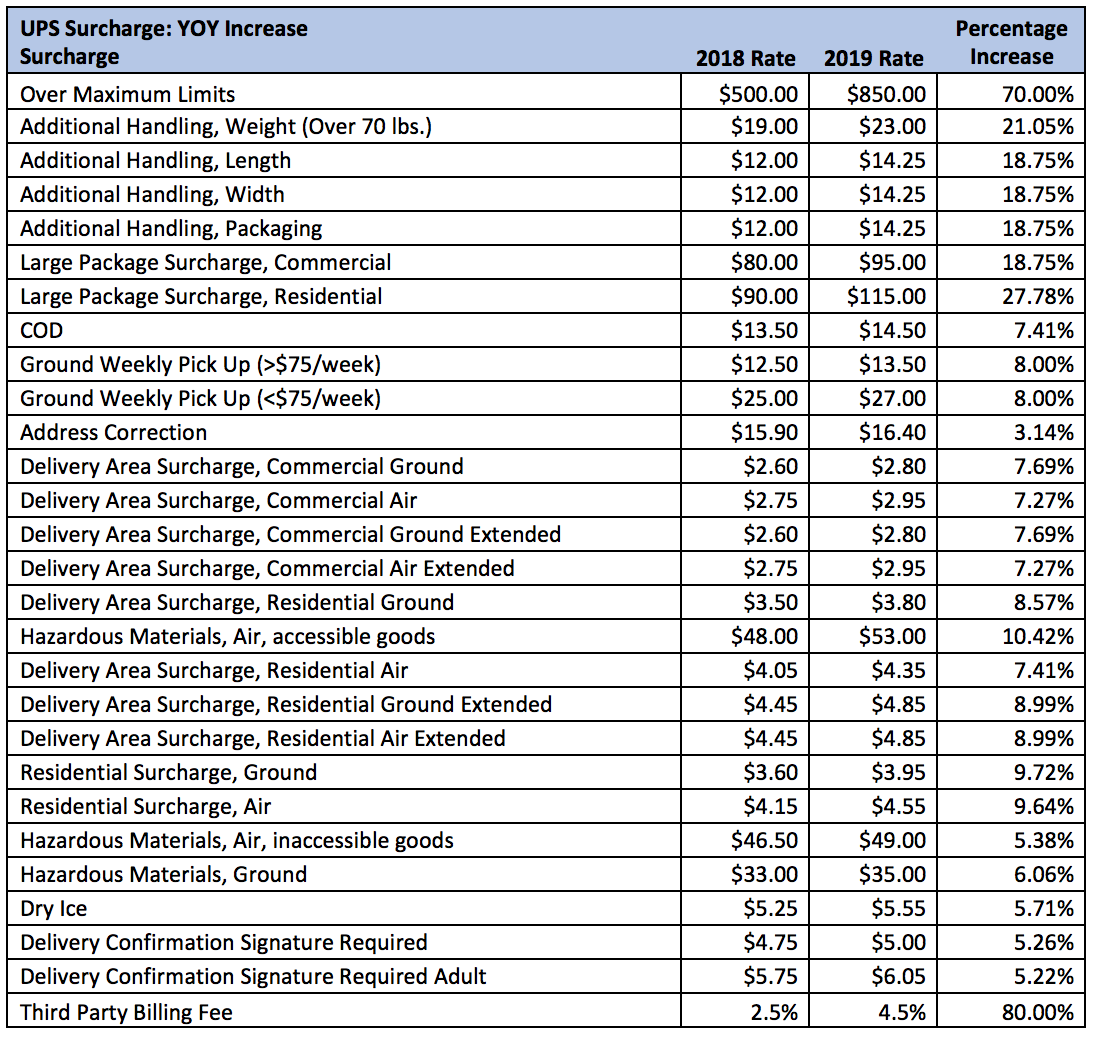
This information not only illustrates the many facets of the 2019 general rate increase but, on the broader level, the continuing efforts of UPS and FedEx to create an increasingly complex pricing environment year after year with varying increases.
When Shipware surveyed shippers, from small to large, at the 2018 PARCEL Forum, 63% of respondents felt that it’s harder to negotiate with the carriers today than it was a few years ago.Among those, 73% felt the difficulty is owed to increased pricing and agreement complexity. It’s also not lost on shippers that the carriers are focused on revenue: keeping margins high and capturing added costs to serve. Of those who believe today’s negotiating landscape is tougher, 82% also feel it’s partly due to this revenue-focused approach that we find in reoccurrences like large packages being assessed multiple increases. With many moving parts to every rate increase; with rates, minimums, and surcharges that no longer match, today’s environment is very confusing for many shippers. It is essential they stay informed and educated if they want to remain in control of their transportation costs.
Expectations for 2019 Mid-Year Increases:
Are Once-Per-Year Increases a Thing of the Past?
If 2018 introduced the new norm, shippers could see mid-year surcharge increases being assessed by both UPS and FedEx once again. Shipware expects increases in the same areas: Large/Oversize packages and Additional Handling. Essentially, the carriers are increasing these fees as a deterrent, forcing shippers to either optimize packaging or move large packages out of the small package network.
Last year, we saw the following UPS surcharges impacted: Fuel, Shipping Charge Corrections, Additional Handling (>70lbs),Large Package Surcharge, andOver Maximum Limits. Regarding fuel, UPS split the fuel surcharge for domestic and international air so that we currently different fuel surcharges for export, import and domestic air. In June, they introduced an audit fee for shipping charge corrections which is the greater of $1 per adjusted package or 6% of the adjusted revenue for an invoice week. As mentioned before, this is now applied when the average shipping charge correction in an invoice week is more than $5, increased from $2 within the same calendar year. Again, the key word here is, “average.” We expect this audit fee to be fair game for an annual increase, similar to the Third-Party Billing Fee which has seen a YOY increases.
In addition, UPS changes for 2019 include applying fuel surcharges to more surcharges than ever before, including: Additional Handling, Over Maximum Limits, Signature, and Adult Signature Required. They are also instituting new fees. They will also charge a processing fee when Package Level Detail (PLD) is not provided to them prior to delivery.
FedEx followed suit with their own mid-year hikes to larger packages, increasing their Additional Handling Charge Weight, Oversize Fee, and Unauthorized Package surcharges. Furthermore, the FedEx Express and FedEx Ground fuel surcharge tables were updated in September, translating into increases for most shippers and effectively eliminating the fuel cost advantage that they’ve held over UPS for years in what was a 75% addition to the Express fuel surcharge table and 1% to the Ground fuel surcharge table. Like UPS, FedEx now has separate tables for export, import and domestic express.
The tables below illustrate the mid-year surcharge increases, ranging from 12.5% to 125%, and overall impact to shippers:
UPS

FedEx

Going forward, it will be harder to pinpoint when increases will occur and how much they will demand of shippers. The days of surcharges increasing once a year as part of the general rate increase may be a thing of the past. Shippers need to be diligent and keep abreast of carrier updates regularly. Transportation spend will continue to increase year over year. The question now is: how many times per year?
When and How to Use SurePost and SmartPost in 2019:
aka Everybody Wants Free Shipping
With free shipping becoming more and more of a required checkout option for internet shoppers, companies are constantly looking to cut their transportation costs and minimize the loss incurred by making it available. FedEx and UPS have adapted by partnering with the US Postal Service (USPS) to handle last mile deliveries on their behalf, thereby reducing their costs and allowing them to offer a less expensive service to their customers. These services are called SmartPost and SurePost, respectively.
What are SurePost and SmartPost?
UPS defines SurePost as an economical ground service that delivers primarily to residences while FedEx defines SmartPost as efficient residential shipping for low-weight packages for both delivery and returns.
Getting a package to its final destination is the most expensive part of its journey and both services were created to help drive down the costs of this “last mile” of delivery.The USPS visits nearly every address in the United States on a daily basis. SurePost and SmartPost leverage this fact by using them for them for the final delivery, allowing UPS and FedEx to avoid delivering a package to a place already visited by the USPS. One thing to note is that SurePost and SmartPost are contracted services, meaning they’re not available to shippers who have not addressed them in their UPS and FedEx agreements.
Services, Surcharges and Shipment Flows
With both SurePost and SmartPost calling on the USPS to execute final deliveries, both offer similar services with matching dimensional, weight and material restrictions, with SmartPost Returns being the differentiator, having no SurePost counterpart.
SurePost is broken down into four services:
- SurePost 1 lb. or Greater (Might be referred to as Parcel Select, the USPS term)
- SurePost less than 1 lb. (Parcel Select Lightweight)
- SurePost Bound Printed Matter
- SurePost Media
While SmartPost is broken down into five services:
- SmartPost 1 lb. or Greater (Might be referred to as Parcel Select)
- SmartPost less than 1 lb. (Parcel Select Lightweight)
- SmartPost Bound Printed Matter
- SmartPost Media
- SmartPost Returns
SurePost 1 lb. or Greaterand SmartPost 1lb. or Greater are the most common services, respectively, for both UPS and FedEx. They allow packages as heavy as 70 pounds with combined length + girth (2*height + 2*width) of 130” or less as long as no dimension is longer than 60”. SurePost less than 1 lb.and SmartPost less than 1lb. both have the same dimensional restriction as their analogous 1 lb. or Greater services, but the shipment must weigh less than 16 ounces.
SurePost Bound Printed Matter (BPM) and SmartPost BPM apply to books and other permanently-bound materials that weigh up to 15 pounds. Both services have a 108” length + girth limit and a 60” maximum for any single dimension. In order to use a BPM service, it must be specifically included in a SurePost or SmartPost agreement.
SurePost Mediaand SmartPost Media are for most forms of media (CDs, DVDs, etc.) and have a 70 pound maximum and a 108” length + girth limit. Like BPM, Media is only available to shippers who specifically include it in their respective SurePost or SmartPost agreement.
As mentioned before, and noted in their definition of SmartPost, FedEx offers one additional service, SmartPost Returns. This is a solution that offers consumers a way to return packages through the USPS using the same restrictions as 1lb or Greater. The caveat is that a shipper must have at least 20 returns per day in order to qualify for this service and it must be specifically included on an agreement. Returns packages may also be dropped off at any FedEx retail location.
When it comes to surcharges:
SurePost has a smaller set of surcharges than UPS Ground that can be added to a shipment:
- Non-Machinable: A package with a dimension between 34” and 48”, any two dimensions between 17” and 30”, or weighing over 35 lbs.
- Delivery Area Surcharge
- Additional Handling: Package with its longest side greater than 48”, second-longest side greater than 30”, encased in metal or wood, or a cylindrical item not fully encased in corrugated
- Peak Surcharge: An extra fee added to Additional Handling during UPS’s busiest time (between mid-November and Christmas)
SmartPost has a smaller set of surcharges than FedEx Home Delivery:
- Non-Machinable: Package with a dimension between greater than 27”, any two dimensions greater than 17”, weighing over 35 lbs., or packaged in a cylindrical tube
- Delivery Area Surcharge
- Balloon: Item that weighs less than 20 lbs. but measures between 84” and 108” in length + girth
- Oversize: Item measuring between 108” and 130” in length + girth
- Package Relabel: Packages that require overlabel or hand keying will be assessed this fee
- Third Party Billing Surcharge: Shipments billed to an account unrelated to the shipper
We know what SurePost and SmartPost are, their similar offerings, why they were created, and what surcharges can be applied. But, what does the flow of a shipment look like in practice?
A SurePost shipment typically goes as follows:
- UPS picks up the shipment as part of their regular pickup.
- UPS consolidates the SurePost shipments and delivers them via their ground network to a USPS Destination Delivery Unit (DDU).
- USPS then sorts the packages to their carrier routes and handle the delivery to the customer.
A SmartPost shipment typically goes as follows:
- FedEx picks up the shipment as part of their regular ground pickup.
- FedEx consolidates the SmartPost shipments and delivers them to one of their 25 SmartPost Hubs.
- The hubs sort the packages to the USPS destination close to the delivery point, not necessarily a DDU.
- USPS then sorts the packages to their carrier routes and handle the delivery to the customer.
Both SurePost and SmartPost use dimensional rating for their packages just like they do for their other services. This takes the volume of the package (L * W * H) and divides it by a DIM divisor (the standard is 139). This dimensional weight is compared to the actual weight and the greater value is used for rating purposes.
As you can see, SurePost and SmartPost are very similar. The package requirements are the same and the service offerings are almost identical, the distinction there being that FedEx offers a SmartPost Returns product that UPS does not. There are a few more differences though. FedEx uses separate SmartPost hubs instead of the regular ground network that UPS uses and, while every SmartPost package will be delivered by the USPS, UPS will deliver SurePost packages if it they are already delivering a regular ground package in the customer’s immediate area. As a result of these differences, the transit time for a SurePost shipment is generally about a day faster than SmartPost.
Additionally, the list rates are different between FedEx and UPS. The 2019 list rates for SurePost and SmartPost are shown below. FedEx’s rates match their ground rates for 1 to 9 pounds in most zones (with a slight difference in the 4 thru 9 pounds rates on zone 4, and 9 pounds rate on zone 3) whereas UPS’s rates are an average of 5.9% higher than their ground rates. Both carriers’ rates increase by almost 30% at the 10 pound mark. Shippers of heavier packages need to calculate if these rates are still beneficial. With the lack of a residential surcharge, they typically will be despite the rate jump, but the savings opportunity is greatly reduced.
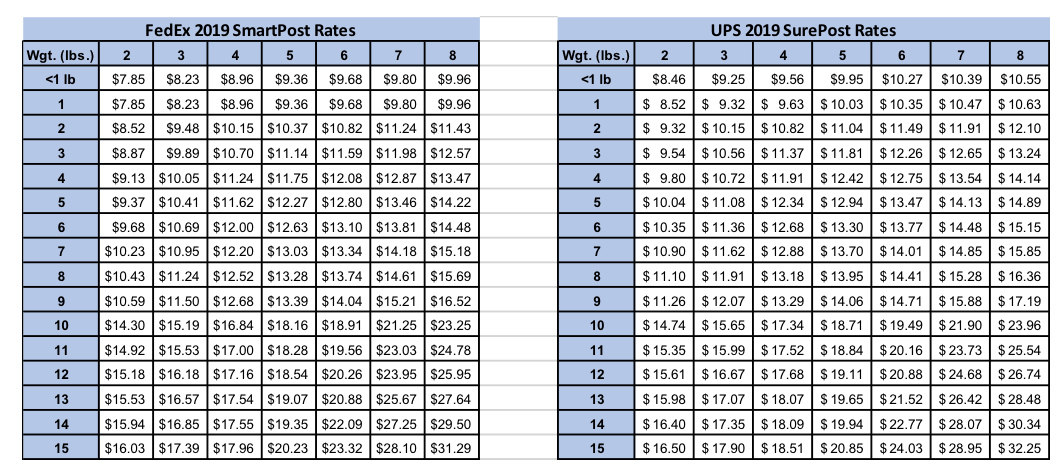
Just like all other services, SurePost and SmartPost have a minimum charge. For UPS, it is the zone 2, 1 lb. rate or the zone 2, 1 lb. ounce rate. For FedEx, it is the zone 2, 1 lb. rate less $2.00 (less $3.00 for ounces). Shippers should factor these minimum charges into their SurePost and SmartPost rate negotiations. UPS is at a much higher starting point than FedEx, so an aggressive concession will be needed.
Now that we’ve defined what SurePost and SmartPost are, let’s look at why shippers should use these services and what to be aware of when considering SurePost or SmartPost.
For both carriers, the advantages include:
- No residential surcharges. This saves $3.95 with both UPS and FedEx, assuming no reductions have been negotiated.
- Lower delivery area surcharges that save up to $2.50 with UPS and $2.75 with FedEx (see the chart below).
- The ability to deliver to PO Boxes, which neither UPS nor FedEx can.
- The ability to deliver to Military APO/FPO/DPO destinations.
- The ability to deliver to US territories.
- Full tracking and visibility just like regular UPS and FedEx shipments.
- Delivery Monday through Saturday everywhere. Currently, FedEx Home Delivery is Tuesday through Saturday and UPS only delivers on Saturday to some locations.
Disadvantages include:
- Slower transit time compared to the carriers’ ground service
- Tracking confusion owed to the package switches carriers (sometimes UPS or FedEx will show the package as “delivered” when it has been handed off to the USPS)
- Collect on delivery is not available
- Package value is capped at $100 and no additional declared value is possible
- Money-back guarantee does not apply because transit times are not defined
- Hazardous materials cannot be shipped
- Signature proof of delivery is not available
- Appointment deliveries are not available
Having said all of that, shippers use SurePost and SmartPost as their “Free Shipping” option most of the time. The lack of residential surcharges, the lower delivery area surcharges and the ability to deliver to just about every location in the country allow them to minimize their losses on transportation. The trade-off of a slower transit time is acceptable for most customers.
Shippers that are interested in using these services need to ensure that their UPS and/or FedEx agreements have SurePost and/or SmartPost pricing on them. Discounts can and should be negotiated as well. Once the services are included, the packages will be picked up as part of the normal process.
The USPS Announces Significant Changes:
A Brief Overview of the 2019 GRI
The 2019 USPS General Rate increase will take effect on January 27, 2019. The reported 5.9% average increase for Priority Mailis understated, as most shippers are using “Commercial Plus” pricing (which is being effectively eliminated) and will take an additional 3% increase. Some lanes, including flat rate envelopes will see a 9% increase.
New Priority Mail dimensional policies will be implemented on June 23rdwherein the Post is dropping the balloon surcharge and decreasing the Dim divisor to 166 from 194.
The First Class Package Service (FCPS)will no longer be a flat rate and is instead switching to zone-based pricing. Inner zones will see a smaller 6.7% increase while outer zone shippers will see a 15% increase. Where pricing used to have just 16 levels based upon the ounce, it will now rise incrementally every 4 ounces.
Parcel Selectis the core USPS class used by consolidators like UPS SurePost and FedEx SmartPost examined in the previous section. There are many ways consolidators use the USPS for final mile delivery, with most using the DDU entry discount. Rates for > 1 LB are going up 10% with the new 166 Dim, while the under-a-pound is increasing an average of 11.5% and willnotbe switching to zone-based pricing like the FCPS.
This is a major rate increase that was carefully planned by the USPS to minimize loss of volume, with the greatest increases being applied to shipping lanes with the least competition. Zone 8 lightweight shippers would be well served to consider fulfilment or adding asecond distribution center to mitigate costs, as will > 1 lb. shippers with higher cubic volume (> 1728 cubic inches) since the Post will grandfather in the Dim exemption for zones 1-4.
How to Compete with Amazon:
Contending with Free Shipping, Shopping Cart Abandonment
Regardless of how we define the “Amazon Effect,” one thing is clear: there’s no denying the digitization of the marketplace has disrupted traditional business models and consumer expectations. Consumers expect an almost entirely frictionless buying experience with near immediate results, including delivery. With immediate access to virtually any product or service via their smart phone, tablet or computer, consumers no longer need to set aside time to run errands at brick and mortar stores.
How can the average shipper compete in this environment? It’s difficult but they should begin by pursuing means to lower their parcel shipping costs(which allows them, theoretically, to charge less for shipping) or decrease transit times. Ideally, both. There are many ways for shippers to accomplish these goals, some dependent on volume and spend and therefore within reach of only the largest shippers, and some not.
Two great ways to reduce cost and shorten delivery time are to increase the number of origin points or to move the origin point as close to the end user as possible. A shorter delivery distance carries a lower rate (usually) and enables faster transit. The largest shippers can open new, strategically placed distribution centers while smaller shippers can consider a direct-to-consumer strategy by having the manufacturer or wholesaler handle shipping or by fulfilling from stores rather than from a primary DC. An omnichannel strategy, which includes shipping from all of the above, can be a great option for many shippers.
Carrier diversification is another strategy that can both reduce cost and decrease transit time. Shippers should consider using multiple carriers where it makes sense. Understanding which carriers are a good fit and which are not is critical to this strategy. Many shippers can benefit from increased usage of USPS as Priority Mail can offer lower costs and faster transit times with 2-day delivery to most of the country. It’s also very important for shippers to understand the impact this strategy will have on the pricing they receive from their primary national carrier as a result of moving volume away from them.
Regional carriers should not be overlooked when trying to hit this lower cost/shorter transit goal. They can be a great option for certain shippers. Regional carriers such as OnTrac on the west coast, LaserShip in the east, UDS in the Midwest and LSO in the southwest can help large shippers offer one- and two-day transit to most population centers in these geographic regions. The ROI on introducing regional carriers will vary, however, from shipper to shipper. The largest shippers, who have favorable delivery density within the footprint of a certain regional carrier, should absolutely be exploring this option.
Packaging optimization can be a key cost-reduction strategy and can help shippers avoid significant, and often unexpected, dimensional weight fees. A shipper’s ability to “right-size” their packaging is critical to reduce the amount of air they’re shipping.
All of the above should include an aggressive rate negotiation strategy with the national carriers. Every aspect of their pricing agreements are negotiable. Discounts, minimum charges, accessorial charges, dimensional weight pricing, etc. can all be negotiated in order to help lower costs. Even the degree of impact the carriers’ annual GRIs have on a given shipper can be mitigated through contract negotiation. Education and data are key here. Shippers must be intimately familiar with their own shipping and package characteristics and should know how to use that information to their advantage during carrier negotiations. Shippers who have taken action to lower the carrier’s cost to serve them, such as adding additional origin points or optimizing their packaging, shouldn’t be afraid to ask for concessions in exchange.
Some shippers have decided that, if you can’t beat them you may as well join them. These shippers, in order to get their product in front of more consumers and offer faster delivery (and, therefore, to compete with Amazon) believe that Fulfillment by Amazon (FBA) is worth the extra cost. How does FBA work? Retailers send their product to Amazon to store it. Orders are placed either through Amazon, directly with the retailer, or through some other eCommerce platform. Amazon picks, packs and ships the item then provides tracking, customer service and returns management. But, all of this comes at a cost to the shipper.
In the coming years, what we think of as the “Amazon Effect” will likely include the impact of Amazon rolling out their own national delivery network, Amazon Shipping, in effort to compete directly with the national carriers. At the time of writing of this article, Amazon had announced a plan to eliminate many of the fees associated with residential deliveries carried out by UPS and FedEx. Although conventional wisdom says that Amazon Shipping is, at minimum, 5 to 7 years away from competing on a large scale, the national carriers stand up and take notice when announcements like this are made, and so should shippers. Stay tuned for more on this topic.
Shipping in 2019: The Big Picture
2018 was another huge year for UPS, FedEx and the USPS. Package volumes continue to rise, and the carriers are racing to keep up with the increased demand. Both UPS and FedEx instituted mid-year increases to surcharges related to size and weight, making it clear that large packages are not welcome in their network without collecting significant fees in turn. Both also changed their fuel surcharge tables, separating domestic express, import, export and ground into separate tables while increasing the surcharge percentage. Peak surcharges were once again implemented in 2018 and we expect to see them in 2019 as well. FedEx and UPS differ in their peak surcharge strategies, so any changes for 2019’s peak season merit attention.
The 2019 rate increases were announced at 4.9% by both carriers. Further analysis reveals that FedEx stayed close to 4.9% on their ground, home delivery and SmartPost rates whereas Express saw significantly higher increases, particularly in the higher zones. UPS’s increase was a little higher for their ground residential and SurePost services while, like FedEx, Express saw significant increases in the higher zones. Remember, that 4.9% does not include accessorials! Both carriers increased their most assessed accessorials, ranging from 5% to 12%, so that needs to be considered in any rate increase calculation.
As we move into 2019, the specter of Amazon looms over everyone. Shippers are looking for ways to lower their transportation costs as customers expect free shipping with every online order. Carrier diversification, regional carriers, package optimization and minimizing delivery distance are different ways shippers can lower their costs to appease expectations. Amazon is building out a delivery network and has already announced a plan to eliminate many of the fees associated with residential deliveries. It remains to be seen how long their plan will take to scale but shippers and carriers will be closely following any developments.